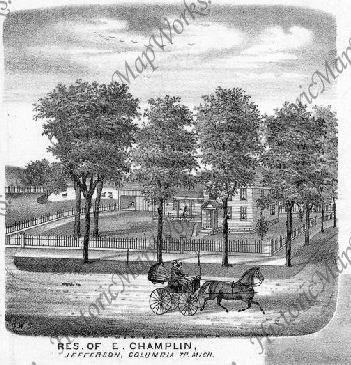Erastus Champlin is the grandfather of Belle Champlin.
Erastus Champlin son of John Champlin and Ann Ray, was born 1803 in Saybrook, Connecticut. He reomoved to Seneca County, New York at the age of 16. He married Margaret Keller. daughter of Henry Keller and Elizabeth. She was born abt. 1809 in New York and died in Michigan. They had 8 children.
Erastus Champlin removed to from Connecticut to western New York, where he owned land and farmed. Erastus removed to Michigan in 1834. He was among the earliest settlers in the tide of immigration to the old northwest, carving a living out of the untamed Michigan territory as a millwright.
 8 8 |
| Western New York, 1820 |
Erastus Champlin removed to from Connecticut to western New York, where he owned land and farmed. Erastus removed to Michigan in 1834. He was among the earliest settlers in the tide of immigration to the old northwest, carving a living out of the untamed Michigan territory as a millwright.
 |
| Erastus Champlin's Jefferson Mills, Colombia Township |
 |
| Jefferson village and Jefferson Cemetery on Lake Colombia |
 |
| Jefferson Mill Pond, now Lake Columbia |
Erastus Champlin, came in 1836 and engaged to work in Ford's Mill. He remained in their employ for six years, when he went to Jefferson to start the flouring mill there. Later he was connected with the Spring Arbor Mills, and also at Jonesville and Homer. He had a good reputation as a miller, and it was said of him that he was strictly honest, in fact that "he never harbored a thief in his mill, or over-tolled the farmer's grist.
-De Land's History of Jackson County, Michigan, 1903
 |
| Erastus Champlin worked 1836 - 1842 at Sharon (Ford) Mills |
 |
| Location of Sharon Mills |
Ford's Mill is listed as the first known engagement of Erastus Champlin in the History of Jackson County. This restored 1835 mill is near those mentioned in connection with Erastus Champlin. So many mills are named that he is thought to have been involved in their establishment, and his occupation is listed in local directories as millwright.
In 1842, Erastus Champlin was employed at Homer Mill on the Kalamazoo River in Homer, Michigan. The old mill burned in 1886.
 |
| Rebuilt grist mill in Homer, Michigan |
In 1842, Erastus Champlin was employed at Spring Arbor Mills.
Two incidents in the early 19th century shed light on Jackson County’s Indian past. Both events were well known to early settlers, and both illustrate the uneasy relations that prevailed between the Indians and white settlers.
The battle of Tippecanoe occurred Nov. 11, 1811, and helped precipitate the War of 1812 a few months later. During the battle, a 35-year-old Potawatomi chief, Whap-ka-zeek, was shot in the left leg. Wounded, he awaited his fate. But after the Indians were routed, Gen. William Henry Harrison’s soldiers took the chief to a field hospital where his leg was amputated. He was nursed back to health, given a crutch and a pony and allowed to return home.
That home was a Potawatomi village near present-day Spring Arbor. When the first white settlers began arriving about 20 years later, Whap-ka-zeek was still living there. The village site is memorialized by the Falling Waters Historic Park at Hammond and S. Cross roads, about a mile southwest of Spring Arbor.
That home was a Potawatomi village near present-day Spring Arbor. When the first white settlers began arriving about 20 years later, Whap-ka-zeek was still living there. The village site is memorialized by the Falling Waters Historic Park at Hammond and S. Cross roads, about a mile southwest of Spring Arbor.
After 1842, Erastus Champlin was employed at Jonesville Mills in Jonesville, Hillsdale, Michigan.
 |
| Rebuilt grist mill in Jonesville, Hillsdale, Michigan |
In 1850, Erastus Champlin resided in Leoni, Jackson, Michigan.
 |
| Location of Leoni millpond and Leoni village |
This census shows that Erastus Champlin in 1850 held 70 ac. improved, and 133 ac. unimproved farmland. The cash value of his land; $2,436, farm equipment; $50. His livestock; 2 horses, 4 milk cows, 2 working oxen, 6 other cattle, 35 sheep, 11 swine. Value of livestock; $365. He produced; 426 bushels of wheat, 150 bushels of Indian corn, 250 bushels of oats.
 |
| Agricultural census for Erastus Champlin in Leoni, 1850 |
In 1850 began the railroad war in which Erastus Champlin became embroiled. His story is detailed below.
In 1860, Erastus Champlin was farming at Spring Arbor, Jackson, Michigan.
 |
| 1860 map of Erastus Champlin's 120 acres, Spring Arbor |
 |
| Spring Arbor Lakes today |
 |
| 1860 census for Erastus Champlin |
In 1866, Erastus Champin is listed with an occupation of manufacturer:
| 1866 Tax List for Erastus Champlin |
| 1870 agricultural schedule for Erastus Champlin |
 |
| 1870 census for Erastus Champlin |
In 1880, Erastus and Margaret (Keller) Champlin resided with their daughter's family in Jefferson.
Death and burial information yet unknown.
Death and burial information yet unknown.


